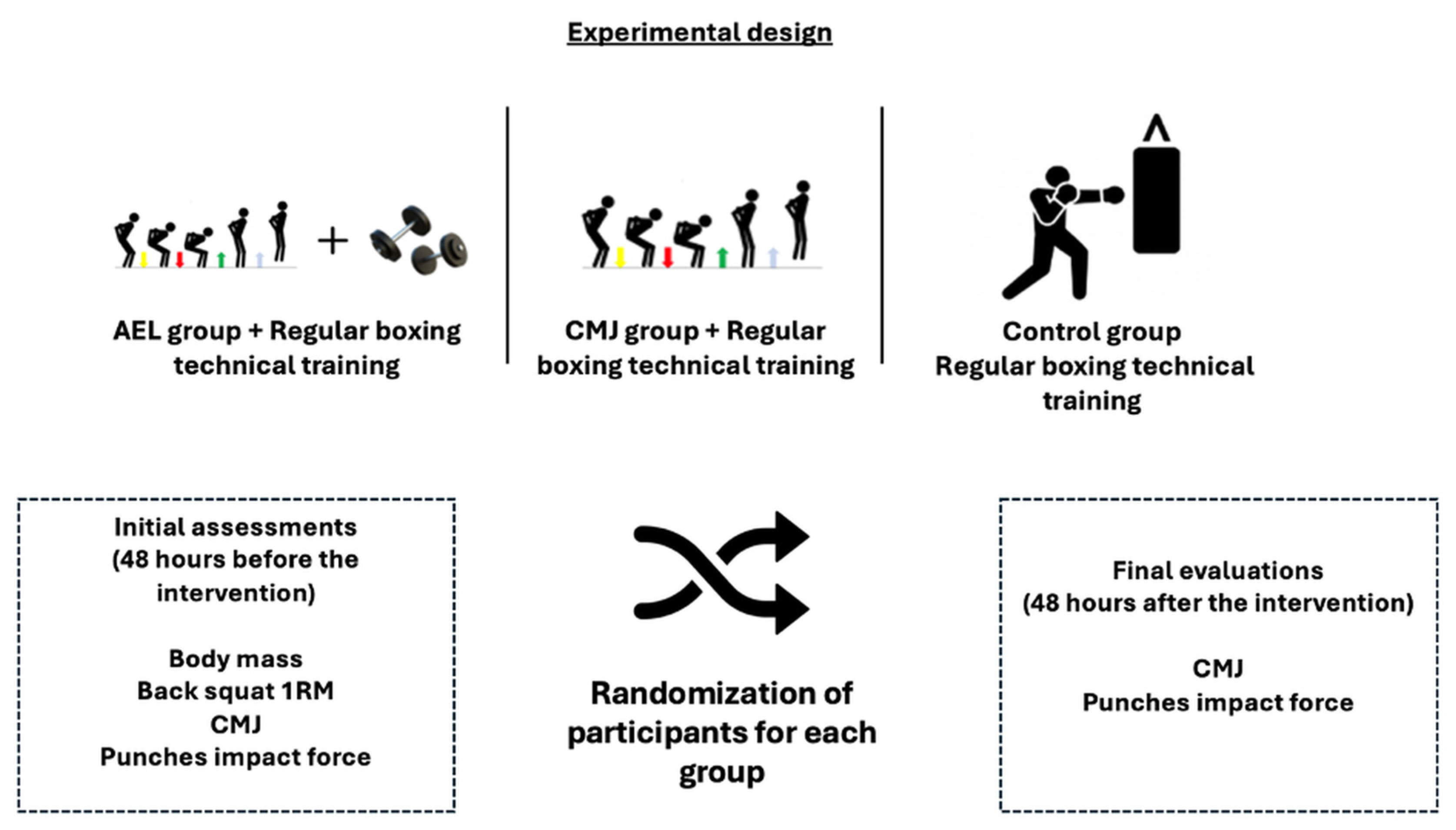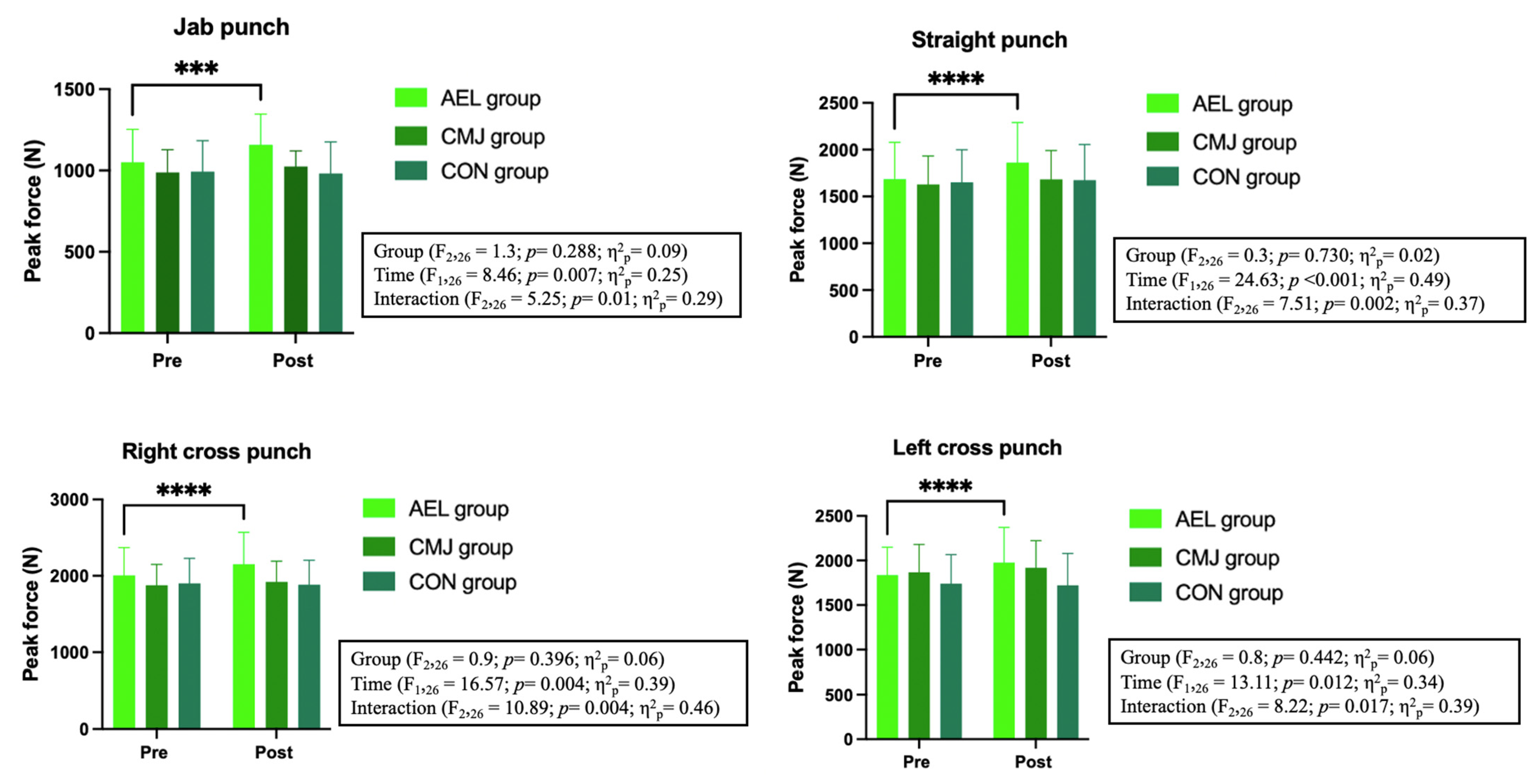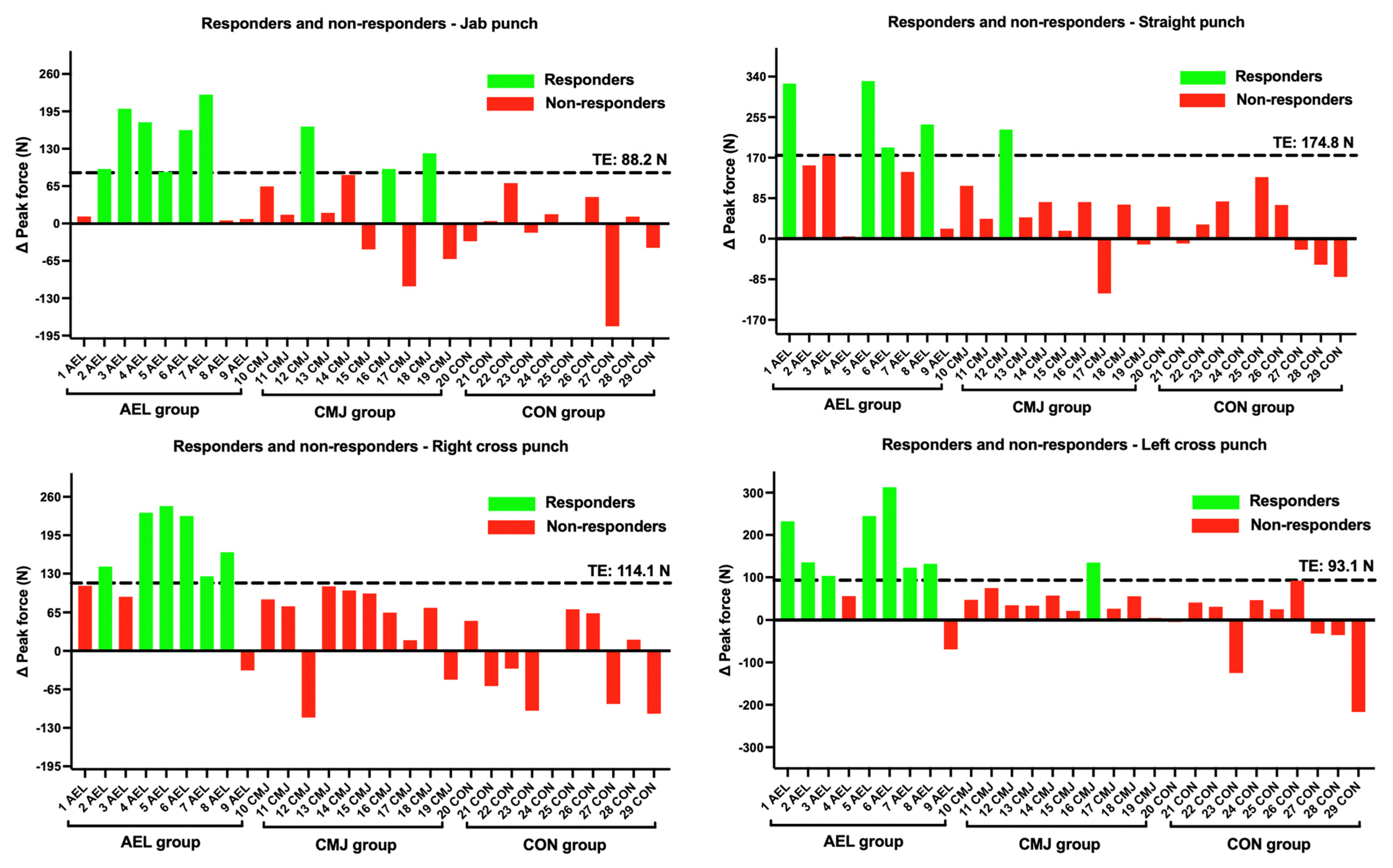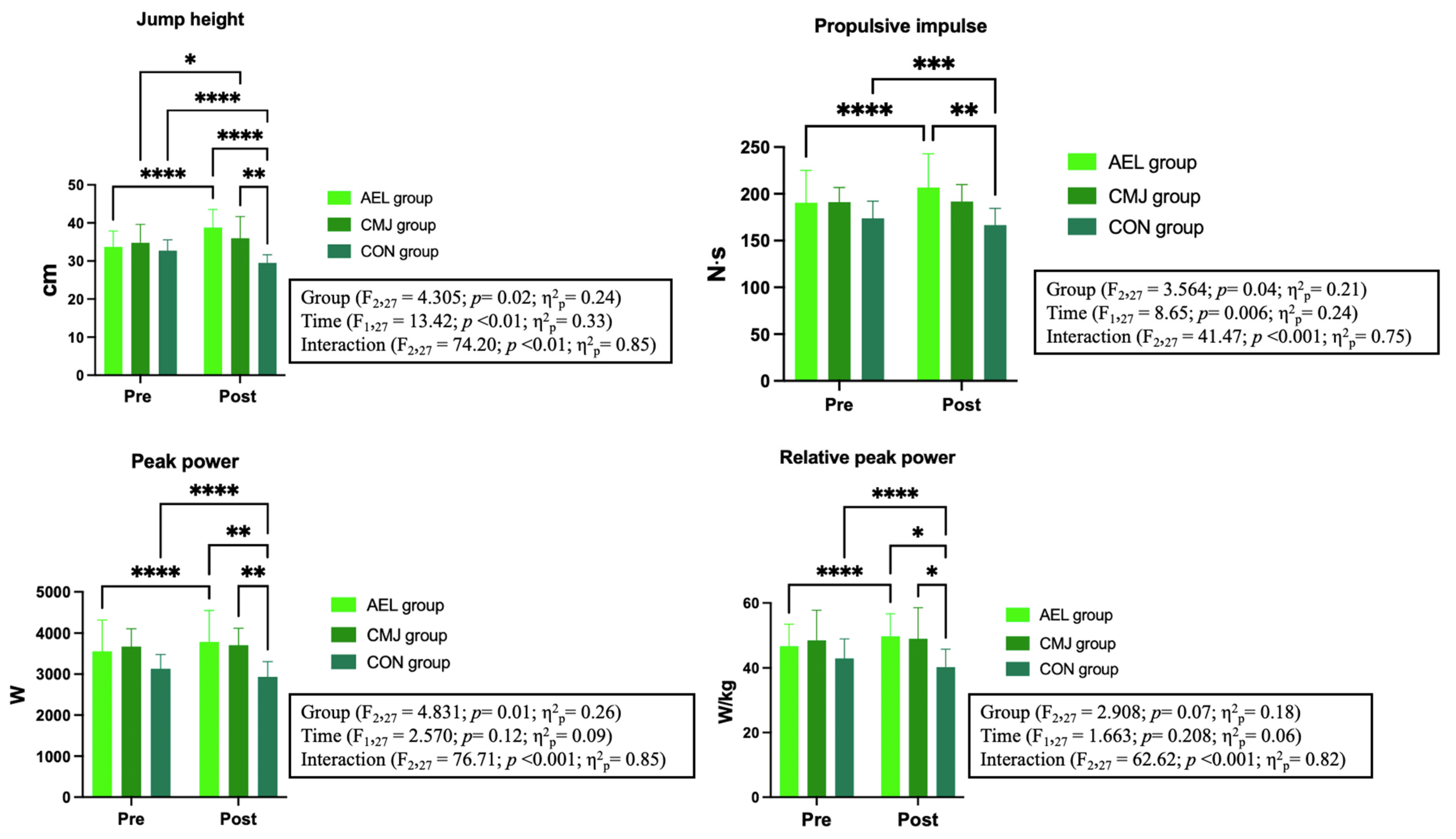Submaximal Accentuated Eccentric Jump Training Improves Punching Performance and Countermovement Jump Force–Time Variables in Amateur Boxers
Abstract
1. Introduction
2. Materials and Methods
2.1. Study Design
2.2. Participants
2.3. Procedures
2.3.1. Regular Boxing Training
2.3.2. Training Protocol
2.4. Assessments
2.4.1. Body Mass
2.4.2. Back Squat One-Repetition Maximum (1RM)
2.4.3. Countermovement Jump (CMJ)
2.4.4. Punching Peak Force
2.5. Data Processing
2.6. Statistical Analysis
3. Results
3.1. Punches Performance
3.2. Countermovement Jump Performance
4. Discussion
4.1. Jab Punch Performance
4.2. Straight Punch Performance
4.3. Right Cross Punch Performance
4.4. Left Cross Punch Performance
4.5. Countermovement Jump Performance
4.6. Relative Strength in Adaptations to Submaximal AEL Training
4.7. Strengths and Limitations of the Study
4.8. Practical Applications
5. Conclusions
Supplementary Materials
Author Contributions
Funding
Institutional Review Board Statement
Informed Consent Statement
Data Availability Statement
Acknowledgments
Conflicts of Interest
References
- Bridgeman, L.A.; McGuigan, M.R.; Gill, N.D. Eccentric Exercise As a Training Modality: A Brief Review. J. Aust. Strength Cond. 2015, 23, 52–64. [Google Scholar]
- Handford, M.J.; Bright, T.E.; Mundy, P.; Lake, J.; Theis, N.; Hughes, J.D. The Need for Eccentric Speed: A Narrative Review of the Effects of Accelerated Eccentric Actions During Resistance-Based Training. Sports Med. 2022, 52, 2061–2083. [Google Scholar] [CrossRef] [PubMed]
- Merrigan, J.; Borth, J.; Taber, C.; Suchomel, T.; Jones, M. Application of Accentuated Eccentric Loading to Elicit Acute and Chronic Velocity and Power Improvements: A Narrative Review. Int. J. Strength Cond. 2022, 2, 1–16. [Google Scholar] [CrossRef]
- Suchomel, T.J.; Wagle, J.P.; Douglas, J.; Taber, C.B.; Harden, M.; Gregory Haff, G.; Stone, M.H. Implementing Eccentric Resistance Training—Part 1: A Brief Review of Existing Methods. J. Funct. Morphol. Kinesiol. 2019, 4, 38. [Google Scholar] [CrossRef]
- Linari, M.; Lucii, L.; Reconditi, M.; Casoni, M.E.; Amenitsch, H.; Bernstorff, S.; Piazzesi, G.; Lombardi, V. A Combined Mechanical and X-Ray Diffraction Study of Stretch Potentiation in Single Frog Muscle Fibres. J. Physiol. 2000, 526, 589–596. [Google Scholar] [CrossRef]
- Wagle, J.P.; Taber, C.B.; Cunanan, A.J.; Bingham, G.E.; Carroll, K.M.; DeWeese, B.H.; Sato, K.; Stone, M.H. Accentuated Eccentric Loading for Training and Performance: A Review. Sports Med. 2017, 47, 2473–2495. [Google Scholar] [CrossRef]
- Aboodarda, S.; Byrne, J.; Samson, M.; Wilson, B.; Mokhtar, A.; Behm, D. Does Performing Drop Jumps with Additional Eccentric Loading Improve Jump Performance? J. Strength Cond. Res. 2014, 28, 2314–2323. [Google Scholar] [CrossRef] [PubMed]
- Aboodarda, S.J.; Yusof, A.; Osman, N.A.A.; Thompson, M.W.; Mokhtar, A.H. Enhanced Performance with Elastic Resistance during the Eccentric Phase of a Countermovement Jump. Int. J. Sports Physiol. Perform. 2013, 8, 181–187. [Google Scholar] [CrossRef]
- Bridgeman, L.; McGuigan, M.; Gill, N.; Dulson, D. The Effects of Accentuated Eccentric Loading on the Drop Jump Exercise and the Subsequent Postactivation Potentiation Response. J. Strength Cond. Res. 2017, 31, 1620–1626. [Google Scholar] [CrossRef]
- Hughes, J.; Massiah, R.; Clarke, R. The Potentiating Effect of an Accentuated Eccentric Load on Countermovement Jump Performance. J. Strength Cond. Res. 2016, 30, 3450–3455. [Google Scholar] [CrossRef]
- Sheppard, M.; Young, K. Using Additional Eccentric Loads to Increase Concentric Performance in the Bench Throw. J. Strength Cond. Res. 2010, 24, 2853–2856. [Google Scholar] [CrossRef] [PubMed]
- Bridgeman, L.; Gill, N.; Dulson, D.; McGuigan, M. The Effect of Exercise-Induced Muscle Damage After a Bout of Accentuated Eccentric Load Drop Jumps and the Repeated Bout Effect. J. Strength Cond. Res. 2017, 31, 386–394. [Google Scholar] [CrossRef] [PubMed]
- Bridgeman, L.; Mcguigan, M.; Gill, N.D. A Case Study Investigating the Effects of an Accentuated Eccentric Load Drop Jump Training Program on Strength, Power, Speed and Change of Direction. Sport Perf. Sci. 2020, 86, 1–4. [Google Scholar]
- Sheppard, J.; Hobson, S.; Barker, M.; Taylor, K.; Chapman, D.; McGuigan, M.; Newton, R. The Effect of Training with Accentuated Eccentric Load Counter-Movement Jumps on Strength and Power Characteristics of High-Performance Volleyball Players. Int. J. Sports Sci. Coach. 2008, 3, 355–363. [Google Scholar] [CrossRef]
- Majeedkutty, N.A.; Yiing, P.S.; Paul, A. Accentuated Eccentric Training: Effects on Horizontal Jump Distance and Muscle Strength among Young Adults. MOJ Yoga Phys. Ther. 2018, 3, 1. [Google Scholar] [CrossRef]
- Beattie, K.; Ruddock, A.D.A.D. The Role of Strength on Punch Impact Force in Boxing. J. Strength Cond. Res. 2022, 36, 2957–2969. [Google Scholar] [CrossRef]
- Sheppard, J.; Newton, R.; McGuigan, M. The Effect of Accentuated Eccentric Load on Jump Kinetics in High-Performance Volleyball Players. Int. J. Sports Sci. Coach. 2007, 2, 267–273. [Google Scholar] [CrossRef]
- Herrera-Valenzuela, T.; Carter, J.; Leiva, E.; Valdés-Badilla, P.; Ojeda-Aravena, A.; Franchini, E. Effect of a Short Hiit Program with Specific Techniques on Physical Condition and Activity during Simulated Combat in National-Level Boxers. Sustainability 2021, 13, 8746. [Google Scholar] [CrossRef]
- Cid-Calfucura, I.; Herrera-Valenzuela, T.; Franchini, E.; Falco, C.; Alvial-Moscoso, J.; Pardo-Tamayo, C.; Zapata-Huenullán, C.; Ojeda-Aravena, A.; Valdés-Badilla, P. Effects of Strength Training on Physical Fitness of Olympic Combat Sports Athletes: A Systematic Review. Int. J. Environ. Res. Public Health 2023, 20, 3516. [Google Scholar] [CrossRef]
- Sandnes, F.E. CANDIDATE: A Tool for Generating Anonymous Participant-Linking IDs in Multi-Session Studies. PLoS ONE 2021, 16, e0260569. [Google Scholar] [CrossRef]
- Foster, C.; Florhaug, J.; Franklin, J.; Gottschall, L.; Hrovatin, L.; Parker, S.; Doleshal, P.; Dodge, C. A New Approach to Monitoring Exercise Training. J. Strength Cond. Res. 2001, 15, 109–115. [Google Scholar] [CrossRef] [PubMed]
- Taber, C.B.; Butler, C.; Dabek, V.; Kochan, B.; Mccormick, K.; Petro, E.; Suchomel, T.J.; Merrigan, J.J. The Effects of Accentuated Eccentric Loading on Barbell and Trap Bar Loaded Countermovement Jumps. Int. J. Strength Cond. 2023, 3, 1–15. [Google Scholar]
- Soriano, P.P. Metodología y Aplicación Práctica de la Biomecánica Deportiva; Paidotribo: Barcelona, España, 2018. [Google Scholar]
- Chiu, L.Z.F.; Dæhlin, T.E. Comparing Numerical Methods to Estimate Vertical Jump Height Using a Force Platform. Meas. Phys. Educ. Exerc. Sci. 2020, 24, 25–32. [Google Scholar] [CrossRef]
- Suchomel, T.J.; Nimphius, S.; Stone, M.H. The Importance of Muscular Strength in Athletic Performance. Sports Med. 2016, 46, 1419–1449. [Google Scholar] [CrossRef] [PubMed]
- Grgic, J.; Lazinica, B.; Schoenfeld, B.J.; Pedisic, Z. Test–Retest Reliability of the One-Repetition Maximum (1RM) Strength Assessment: A Systematic Review. Sports Med. Open 2020, 6, 31. [Google Scholar] [CrossRef] [PubMed]
- Bishop, C.; Jordan, M.; Torres-Ronda, L.; Loturco, I.; Harry, J.; Virgile, A.; Mundy, P.; Turner, A.; Comfort, P. Selecting Metrics That Matter: Comparing the Use of the Countermovement Jump for Performance Profiling, Neuromuscular Fatigue Monitoring, and Injury Rehabilitation Testing. Strength Cond. J. 2023, 45, 545–553. [Google Scholar] [CrossRef]
- Finlay, M.J.; Page, R.M.; Greig, M.; Bridge, C.A. Test-Retest Reliability and Sensitivity of Senior Elite Amateur Boxers Maximal Punch Force, as Quantified by a Vertically Mounted Force Plate. PLoS ONE 2023, 18, e0289791. [Google Scholar] [CrossRef]
- Blazevich, A.J.; Babault, N. Post-Activation Potentiation Versus Post-Activation Performance Enhancement in Humans: Historical Perspective, Underlying Mechanisms, and Current Issues. Front. Physiol. 2019, 10, 1359. [Google Scholar] [CrossRef]
- Hopkins, W.G.; Marshall, S.W.; Batterham, A.M.; Hanin, J. Progressive Statistics for Studies in Sports Medicine and Exercise Science. Med. Sci. Sports Exerc. 2009, 41, 3–12. [Google Scholar] [CrossRef]
- Bonafiglia, J.T.; Rotundo, M.P.; Whittall, J.P.; Scribbans, T.D.; Graham, R.B.; Gurd, B.J. Inter-Individual Variability in the Adaptive Responses to Endurance and Sprint Interval Training: A Randomized Crossover Study. PLoS ONE 2016, 11, e0167790. [Google Scholar] [CrossRef]
- Ramirez-Campillo, R.; Alvarez, C.; Gentil, P.; Moran, J.; García-Pinillos, F.; Alonso-Martínez, A.M.; Izquierdo, M. Inter-Individual Variability in Responses to 7 Weeks of Plyometric Jump Training in Male Youth Soccer Players. Front. Physiol. 2018, 9, 1156. [Google Scholar] [CrossRef] [PubMed]
- Kim, K.-J.; Lee, S.-B.; Park, S. Effects of Boxing-Specific Training on Physical Fitness and Punch Power in Korean National Boxers. Exerc. Sci. 2018, 27, 296–302. [Google Scholar] [CrossRef]
- Bu, X. Experimental Study on the Effect of Speed Strength Training on the Special Strikes of Chinese Female Boxers. J. Environ. Public Health 2022, 2022, 5912231. [Google Scholar] [CrossRef] [PubMed]
- Čepulenas, A.; Bružas, V.; Mockus, P.; Subačius, V. Impact of Physical Training Mesocycle on Athletic and Specific Fitness of Elite Boxers. Arch. Budo 2011, 7, 33–39. [Google Scholar]
- Dunn, E.C.; Humberstone, C.E.; Franchini, E.; Iredale, K.F.; Blazevich, A.J. Relationships between Punch Impact Force and Upper-and Lower-Body Muscular Strength and Power in Highly Trained Amateur Boxers. J. Strength Cond. Res. 2022, 36, 1019–1025. [Google Scholar] [CrossRef]
- Mosler, D.; Kacprzak, J.; Wąsik, J. Higher Values of Force and Acceleration in Rear Cross Than Lead Jab: Differences in Technique Execution by Boxers. Appl. Sci. 2024, 14, 2830. [Google Scholar] [CrossRef]
- Lenetsky, S.; Brughelli, M.; Nates, J.; Cross, R.; Nates, R.J.R.J.; Cross, M.R.M.R.; Lormier, A.V. Variability and Reliability of Punching Impact Kinetics in Untrained Participants and Experienced Boxers. J. Strength Cond. Res. 2018, 32, 1838–1842. [Google Scholar] [CrossRef]
- Finlay, M.J.; Greig, M.; Bridge, C.A.; Page, R.M. Post-Activation Performance Enhancement of Punch Force and Neuromuscular Performance in Amateur Boxing: Toward a More Individualized and “Real-World” Approach. J. Strength Cond. Res. 2024, 38, 1063–1071. [Google Scholar] [CrossRef]
- Stanley, E.; Thomson, E.; Smith, G.; Lamb, K.L. An Analysis of the Three-Dimensional Kinetics and Kinematics of Maximal Effort Punches among Amateur Boxers. Int. J. Perform. Anal. Sport 2018, 18, 835–854. [Google Scholar] [CrossRef]
- Turner, A.; Baker, E.; Miller, S. Increasing the Impact Force of the Rear Hand Punch. Strength Cond. J. 2011, 33, 2–9. [Google Scholar] [CrossRef]
- Cheraghi, M.; Agha Alinejad, H.; Arshi, A.R.; Shirzad, E. Kinematics of Straight Right Punch in Boxing. Ann. Appl. Sport Sci. 2014, 2, 39–50. [Google Scholar] [CrossRef]
- Lenetsky, S.; Harris, N.; Brughelli, M. Assessment and Contributors of Punching Forces in Combat Sports Athletes: Implications for Strength and Conditioning. Strength Cond. J. 2013, 35, 1–7. [Google Scholar] [CrossRef]
- Kulig, K.; Powers, C.M.; Shellock, F.G.; Terk, M. The Effects of Eccentric Velocity on Activation of Elbow Flexors: Evaluation by Magnetic Resonance Imaging. Med. Sci. Sports Exerc. 2001, 33, 196–200. [Google Scholar] [CrossRef]
- Lenetsky, S.; Brughelli, M.; Nates, R.J.R.J.; Neville, J.G.G.; Cross, M.R.M.R.; Lormier, A.V. Defining the Phases of Boxing Punches: A Mixed-Method Approach. J. Strength Cond. Res. 2020, 34, 1040–1051. [Google Scholar] [CrossRef]
- Del Valle, A.; Thomas, C.K. Firing Rates of Motor Units during Strong Dynamic Contractions. Muscle Nerve 2005, 32, 316–325. [Google Scholar] [CrossRef] [PubMed]
- Dunn, E.C.; Humberstone, C.E.; Iredale, K.F.; Blazevich, A.J. A Damaging Punch: Assessment and Application of a Method to Quantify Punch Performance. Transl. Sports Med. 2019, 2, 146–152. [Google Scholar] [CrossRef]
- Douglas, J.; Pearson, S.; Ross, A.; McGuigan, M. Chronic Adaptations to Eccentric Training: A Systematic Review. Sports Med. 2017, 47, 917–941. [Google Scholar] [CrossRef] [PubMed]
- Duchateau, J.; Enoka, R.M. Neural Control of Lengthening Contractions. J. Exp. Biol. 2016, 219, 197–204. [Google Scholar] [CrossRef]
- Douglas, J.; Pearson, S.; Ross, A.; McGuigan, M. Eccentric Exercise: Physiological Characteristics and Acute Responses. Sports Med. 2017, 47, 663–675. [Google Scholar] [CrossRef]
- Gruber, M.; Linnamo, V.; Strojnik, V.; Rantalainen, T.; Avela, J. Excitability at the Motoneuron Pool and Motor Cortex Is Specifically Modulated in Lengthening Compared to Isometric Contractions. J. Neurophysiol. 2009, 101, 2030–2040. [Google Scholar] [CrossRef]
- Cronin, J.; McNair, P.J.; Marshall, R.N. Velocity Specificity, Combination Training and Sport Specific Tasks. J. Sci. Med. Sport 2001, 4, 168–178. [Google Scholar] [CrossRef] [PubMed]
- Bright, T.E.; Harry, J.R.; Lake, J.; Mundy, P.; Theis, N.; Hughes, J.D. Methodological Considerations in Assessing Countermovement Jumps with Handheld Accentuated Eccentric Loading. Sports Biomech. 2024, 6, 1–18. [Google Scholar] [CrossRef] [PubMed]
- Douglas, J.; Pearson, S.; Ross, A.; McGuigan, M. Effects of Accentuated Eccentric Loading on Muscle Properties, Strength, Power, and Speed in Resistance-Trained Rugby Players. J. Strength Cond. Res. 2018, 32, 2750–2761. [Google Scholar] [CrossRef] [PubMed]
- Taube, W.; Leukel, C.; Gollhofer, A. How Neurons Make Us Jump: The Neural Control of Stretch-Shortening Cycle Movements. Exerc. Sport Sci. Rev. 2012, 40, 106–115. [Google Scholar] [CrossRef]
- Gross, M.; Seiler, J.; Grédy, B.; Lüthy, F. Kinematic and Kinetic Characteristics of Repetitive Countermovement Jumps with Accentuated Eccentric Loading. Sports 2022, 10, 74. [Google Scholar] [CrossRef]






| Variables | AEL (n = 9) | CMJ (n = 10) | CON (n = 10) | p | F Value | η2p |
|---|---|---|---|---|---|---|
| Age (years) | 26.6 ± 4.6 | 26.8 ± 4.5 | 27.5 ± 4.8 | 0.93 | F(2,27) 0.21 | 0.04 |
| Height (cm) | 1.75 ± 0.02 | 1.74 ± 0.06 | 1.75 ± 0.06 | 0.53 | F(2,27) 1.65 | 0.04 |
| Body mass (kg) | 76.9 ± 8.3 | 77.2 ± 11.8 | 73.9 ± 11.7 | 0.75 | F(2,27) 1.62 | 0.02 |
| Back squat 1RM (kg) | 112 ± 1 | 110 ± 1 | 110 ± 2 | 0.95 | F(2,27) 0.57 | 0.003 |
| Relative strength (kg/kg) | 1.5 ± 0.2 | 1.4 ± 0.1 | 1.5 ± 0.2 | 0.42 | F(2,27) 0.90 | 0.007 |
Disclaimer/Publisher’s Note: The statements, opinions and data contained in all publications are solely those of the individual author(s) and contributor(s) and not of MDPI and/or the editor(s). MDPI and/or the editor(s) disclaim responsibility for any injury to people or property resulting from any ideas, methods, instructions or products referred to in the content. |
© 2025 by the authors. Licensee MDPI, Basel, Switzerland. This article is an open access article distributed under the terms and conditions of the Creative Commons Attribution (CC BY) license (https://creativecommons.org/licenses/by/4.0/).
Share and Cite
Sánchez-Ramírez, C.; Cid-Calfucura, I.; Hernandez-Martinez, J.; Cancino-López, J.; Aedo-Muñoz, E.; Valdés-Badilla, P.; Franchini, E.; García-García, J.M.; Calvo-Rico, B.; Abián-Vicén, J.; et al. Submaximal Accentuated Eccentric Jump Training Improves Punching Performance and Countermovement Jump Force–Time Variables in Amateur Boxers. Appl. Sci. 2025, 15, 7873. https://doi.org/10.3390/app15147873
Sánchez-Ramírez C, Cid-Calfucura I, Hernandez-Martinez J, Cancino-López J, Aedo-Muñoz E, Valdés-Badilla P, Franchini E, García-García JM, Calvo-Rico B, Abián-Vicén J, et al. Submaximal Accentuated Eccentric Jump Training Improves Punching Performance and Countermovement Jump Force–Time Variables in Amateur Boxers. Applied Sciences. 2025; 15(14):7873. https://doi.org/10.3390/app15147873
Chicago/Turabian StyleSánchez-Ramírez, Celso, Izham Cid-Calfucura, Jordan Hernandez-Martinez, Jorge Cancino-López, Esteban Aedo-Muñoz, Pablo Valdés-Badilla, Emerson Franchini, José Manuel García-García, Bibiana Calvo-Rico, Javier Abián-Vicén, and et al. 2025. "Submaximal Accentuated Eccentric Jump Training Improves Punching Performance and Countermovement Jump Force–Time Variables in Amateur Boxers" Applied Sciences 15, no. 14: 7873. https://doi.org/10.3390/app15147873
APA StyleSánchez-Ramírez, C., Cid-Calfucura, I., Hernandez-Martinez, J., Cancino-López, J., Aedo-Muñoz, E., Valdés-Badilla, P., Franchini, E., García-García, J. M., Calvo-Rico, B., Abián-Vicén, J., & Herrera-Valenzuela, T. (2025). Submaximal Accentuated Eccentric Jump Training Improves Punching Performance and Countermovement Jump Force–Time Variables in Amateur Boxers. Applied Sciences, 15(14), 7873. https://doi.org/10.3390/app15147873














